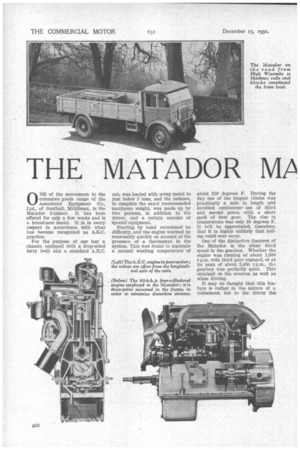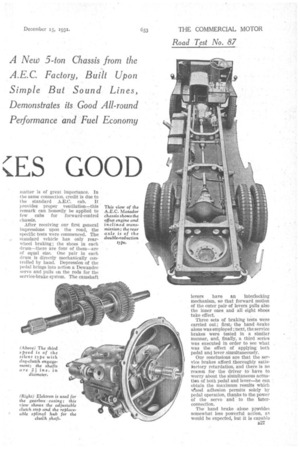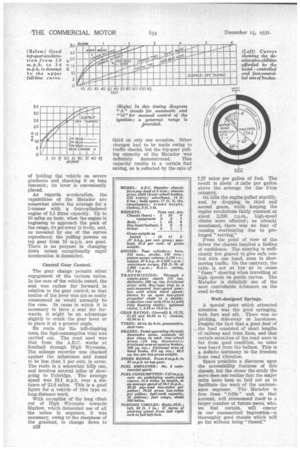THE MATADOR MA GOOD
Page 44

Page 45

Page 46

If you've noticed an error in this article please click here to report it so we can fix it.
A New S-ton Chassis from the A.E.C. Factory, Built Upon Simple But Sound Lines, Demonstrates its Good All-round Performance and Fuel Economy
0 NE of the newcomers to the extensive goods range of the Associated Equipment Co., Ltd., of Southall, Middlesex, is the Matador 5-tonner. It has been offered for only a few weeks and is a brand-new model. It is in every respect in accordance with what has become recognized as A.E.C.• practice.
For the purpose of our test a chassis, equipped with a drop-sided lorry body and a standard A.E.C.
cab, was loaded with scrap metal to just below 5 tons, and the balance, to complete the exact recommended -maximum weight, was made up by two persons, in addition to the driver, and a certain amount of special equipment.
Starting by hand occasioned no difficulty, and the engine warmed up reasonably quickly on account of the presence of a thermostat in the system. This was found to maintain a normal working temperature of
(Left) The A.E.C. engine in part section; the valves are offset from the Iongitudenal axis of the unit.
(Below) The 80-b.lt.p. four-cylindered engine employed in the Matador ; it is three-point mounted in the frame, in order to minimize distortion stresses.
about 120 degrees F. During the day one of the longest climbs was practically a mile in length and involved continuous' use of third and second gears, with a short spell of first gear. The rise in temperature was only 18 degrees F. It will be appreciated, therefore, that it is highly unlikely that boiling could ever occur.
One of the distinctive features of the Matador is the silent third speed in the gearbox. Whether the engine was running at about 1,000 r.p.m. with third gear engaged, or at its peak of about 2,400 r.p.m„ th2 gearbox was perfectly quiet. This obtained on the overrun as well as when driving.
It may be thought that this feature is rather in the nature of a refinement, but to the driver the matter is of great importance. In the same connection, credit is due to t he standard A.E.C. cab. It provides proper ventilation, this remark can honestly be applied to few cabs for forward-control chassis.
After receiving our first general impressions upon the road, the specific tests were commenced. The standard vehicle has only rearwheel braking; the shoes in each drum—there are four of them—are of equal size. One pair in each drum is directly mechanically controlled by hand. Depression of the pedal brings into action a Dewandre servo and pulls on the rods for the service-brake system. The camshaft levers have tm interlocking mechanism, so that forward motion of the outer pair of levers pulls also the inner ones and all eight shoes take effect.
Three sets of braking tests were carried out; first,the hand brake alone was employed ; next, the service brakes were tested in a similar manner, and, finally, a third series was executed in order to see what was the effect of applying both pedal and lever simultaneously.
Our conclusions are that the service brakes afford .thoroughly antisliactory retardation, and there is no reason for the driver to have to worry about the simultaneons actuatien of both pedal and lever—he can obtain the maximum results which wieel adhesion permits solely by pedal operation, thanks to the power of the servo and to the interconnection.
The hand brake alone provides somewhat less powerful action, as would be expected, but it is capable n27 of holding the vehicle on severe gradients and checking it on long descents ; its lever is conveniently placed.
As regards acceleration, the capabilities of the Matador are somewhat above the average for a 5-tonner -with a fomecylindered engine of 5.1 litres capacity. Up to 30 miles an hour, when the engine is beginning to approach the peak of the range, its get-away is lively, and, as revealed by one of the curves reproduced, the pulling powers on top gear from 10 m.p.h. are good. There is no purpose in changing down unless exceptionally rapid acceleration is demanded.
Central Gear Control.
The gear change permits silent engagement of the various ratios. In the case of the vehicle tested, the seat was rather far forward in relation to the gear control, so that motion of the lever was not so easily commenced as would normally be the case. In cases in which it is necessary to have a seat far forwards, it might be an advantage slightly to crank the gear lever or to place it at a greater angle.
En route for 'the hill-climbing tests, the fuel-consumption trial was carried out. The road used was that from the A.E.C. works at Southall through High Wycombe. The mileage recorder was checked against the milestones and found to be less than 1 per cent. in error. The route is a somewhat hilly one, and involves several miles of slowgoing to Uxbridge. The average speed was 19.1 m.p.h. over a distance of 21.5 miles. This is a good figure for a vehicle of this type on long-distance work.
With exception of the long climb out of High Wycombe towards Marlow, which demanded use of all the ratios in sequence, it was necessary, owing bre the steepness of the gradient, to change down to • s28 third on only one occasion. Other changes had to be made owing to traffic checks, but the top-gear pulling capacity of the Matador was definitely demonstrated. This capacity results in a certain fuel saving, as is reflected by the rate of 7.27 miles per gallon of fuel. The result is about .4 imile per gallon above the average for the 5-ton category.
On hills the engine pulled sturdily, and, by dropping to third and second gears, while keeping the engine revolutions fairly constant at about 2,200 r.p.m., high-speed climbs were effected ; as already mentioned, there was no fear of causing overheating due to prolonged "revving."
From the point of view of the driver the chassis inspires a feeling of confidence. The steering is sufficiently low geared to give safe control with one hand, even in slowmoving traffic. On the contrary, the ratio is not so low as to cause " fussy " steering when travelling at high speeds on gentle curves. The Matador is definitely one of the most controllable 5-tormers on the road to-day.
Welldesigned Springs.
A special point which attracted attention was the goad springing, both fore and aft. There was no pitching, side-sway or harshness. Despite the fact that a good deal of the load consisted of short lengths of railway and tram lines, and that certain stretches of the road were in far from good condition, no noise was heard from the ballast. This is a definite testimony to the freedom from road vibration.
Space prohibits a discourse upon the accessibility features of this chassis, but the closer the study the more does one realize that the major units have been so laid out as to facilitate the work of the maintenance engineer. The Matador is free from " frills " and, on that account, will recommend itself to a larger number of future users, who, we feel certain, will concur in our summarized impression—a thoroughly good chassis which will go far without being "fussed."




































































































